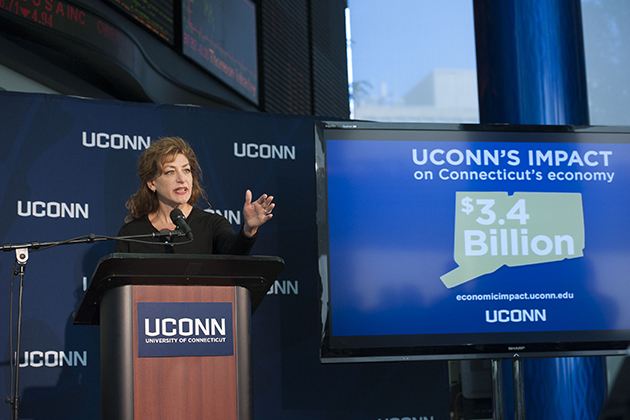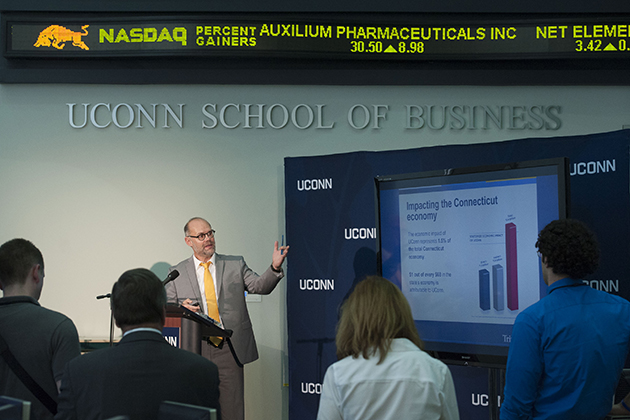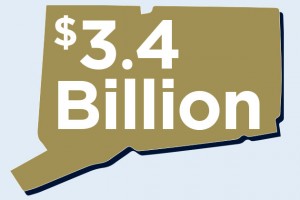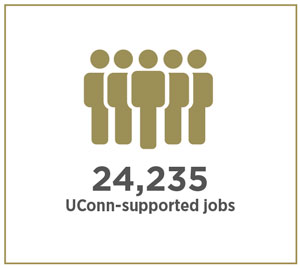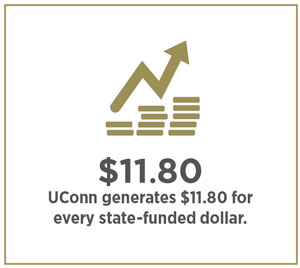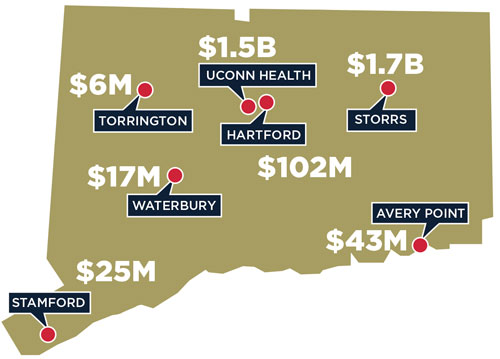President Susan Herbst, top, Gov. Dannel P. Malloy, below left, and Paul Umbach, principal of Tripp Umbach, discuss a report on the economic impact of the University during an event at UConn’s SS&C Technologies Financial Accelerator in Hartford on Sept. 17. (Peter Morenus/UConn Photos)
The University of Connecticut generates about $3.4 billion worth of economic activity every year in the state, including more than 24,000 jobs and over $202 million in tax revenue, according to a report released Wednesday by the national research and consulting firm Tripp Umbach.
The report is the most comprehensive measurement to date of the economic value UConn provides to Connecticut, taking in everything from research grants won to the charitable contributions of students, faculty, and staff members.
“This report provides an empirical foundation for concluding what’s long been clear anecdotally: UConn is essential to the success of our state,” said University President Susan Herbst. “This research also provides a baseline we can use to measure our success as we embark on new initiatives like Next Gen Connecticut and the UConn Technology Park.”
Tripp Umbach, a national leader in economic impact analysis with past clients ranging from Penn State to the University of North Carolina to General Electric, used data from University sources to measure UConn’s economic activity in fiscal year 2013.
“Today’s announcement demonstrates that UConn is more than a university – it’s a unique resource that can be leveraged to create new jobs and sustain long-term economic growth and innovation across Connecticut,” said Gov. Dannel P. Malloy, who, in 2013, introduced and signed P.A. 13-233, An Act Concerning Next Generation Connecticut. “UConn’s economic impact will continue to grow with investments like Next Generation Connecticut that create jobs, spur business activity, and help position Connecticut as a global destination in science and research.”
The study assessed both direct economic impact – money spent by the institution itself – and indirect impact, which measures the re-spending of dollars within the local economy by businesses and households.
Among other significant findings, Tripp Umbach reports that:
- UConn generates $1.5 billion in direct economic impact and $1.9 billion in indirect impact;
- UConn supports about 24,235 jobs, both directly and indirectly, or one out of every 90 jobs in Connecticut;
- UConn generates around $202 million in state and local tax revenues;
- Research at UConn is worth roughly $373 million to the Connecticut economy;
- Volunteering, donations, and charity health care by the UConn community is worth $54.2 million a year.
“UConn is an integral piece of Connecticut’s economy, and University operations directly or indirectly impact residents of Connecticut,” the report concludes, adding that the analysis of UConn compares favorably to the economic impact of other universities around the country.
The report, which can be found at economicimpact.uconn.edu, doesn’t merely consider the University’s impact in the aggregate, but drills down into the economic benefits provided by UConn’s individual campuses, together with UConn Health.
According to the report, UConn’s Storrs campus is responsible for about $1.7 billion worth of economic activity every year, along with $1.5 billion at UConn Health; $102 million at the Hartford campus; $43 million at Avery Point; $25 million at Stamford; $17 million at Waterbury; and $6 million at Torrington.
That economic impact is likely to continue to grow, with projects like the UConn Technology Park and Next Gen Connecticut, which were developed with support from the Governor and state lawmakers and which are already under way.
“It’s gratifying to know that the work our faculty, staff, and students do every day has such a direct impact on the lives of Connecticut residents,” Herbst said. “But this is only the beginning of what we’re capable of achieving.”
